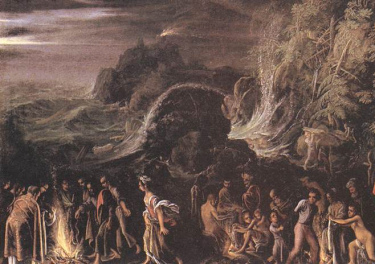The ship, after a few stops along the way, has to sail near the island of Crete due to the wind. It stays in the Cretan city of Fair Havens for a short time before making its dangerous Mediterranean journey to Rome.
The ship, after leaving Crete, runs into a fierce storm. The crew then loses control of the vessel which causes it to wander the sea for about two weeks (Acts 27:13 - 27). As the ship approaches Malta it is run aground and begins to break up.
Then they cut away the anchors and left them in the sea . . . As for the rest, some came from the ship on boards, and others on some of the things from the ship; and so it came to pass that everyone was brought safely to the land. Now when they (Paul, Luke and others) were safe, they learned that the island was called Melita (Malta - Acts 27:41 to 28:1, HBFV throughout).

Painting of Paul at Malta
The above painting of Malta depicts two separate sections from the book of Acts (Acts 27:41 - 28:1 and 28:2 - 6). The background shows the tumultuous Mediterranean Sea and a small beacon burning on the top of a cliff. This represents the shipwreck Paul experienced near Malta (Luke was with him) after the vessel he was on ran into stormy weather sometime after leaving Crete and then was "lost" at sea for at least two weeks.
The second scene depicted, in the bottom left half of the painting, is Paul at Malta shaking off into a campfire a viper that had wrapped itself around his arm. The pagan natives of Malta first thought that fate caused the viper to attack the apostle for some serious crime he committed.
Snake Bite!
When a poisonous snake wrapped around Paul's arm, the pagan natives of Malta thought he was a murderer who, through some unknown power or even fate, was going to be punished for his sins. Their minds soon changed, however, when Paul simply shook the snake into a fire (a fulfillment of one of Jesus' prophecies regarding those who preach the gospel - see Mark 16:18). In fact, those on Malta began to believe that he was a god!
And the barbarians (of Malta) showed us uncommon kindness; for they kindled a fire because of the rain that was falling and because of the cold and received all of us . . .
And when the barbarians saw the snake hanging from his hand, they said to one another, "No doubt, this man is a murderer . . .
But he shook the snake off into the fire and suffered no injury. Now they were expecting him to become swollen, or suddenly fall down dead. But when they watched for a long time and saw that no harm came to him, they changed their opinion and said that he was a god (Acts 28:2 - 6).
Performing Miracles!
While he was on Malta an important official named Publius hosted the apostle and others for three days (Acts 28:7). During his stay he not only heals Publius' father of a sickness (possibly malaria), but also many others.
Now it happened that Publius’ father lay afflicted with fevers and dysentery; but Paul came to him and prayed for him, and laid his hands on him and healed him.
So then, after this took place, the others on the island who had infirmities came and were healed. (Acts 28:8 - 9).
After spending three months on the island Paul, and those who survived the shipwreck, got on a ship from Alexandria and sailed to the port of Syracuse on Sicilia (Acts 28:11 - 12).
As an interesting side note, at one time some scholars thought Luke (the writer of Acts who accompanied Paul) made an error in referencing Publius' title as the "chief man of the island" (Acts 28:7, KJV). Inscriptions, however, were eventually found that verified Luke accurately recorded his title (Encyclopedia of Bible Facts, section on Publius of Malta).